Themed collection Most popular 2018-2019 catalysis articles

Revealing the nature of active sites in electrocatalysis
In this perspective, key aspects for the identification, design and optimization of active centers at the surface of electrocatalysts are analyzed.
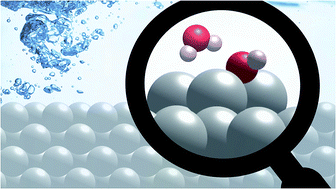
Chem. Sci., 2019,10, 8060-8075
https://doi.org/10.1039/C9SC02654A
Regulating C–C coupling in thermocatalytic and electrocatalytic COx conversion based on surface science
This article outlines the recent advances in catalyst design for controlling C–C coupling in syngas conversion, CO2 hydrogenation and CO2 electroreduction from the viewpoint of surface science.

Chem. Sci., 2019,10, 7310-7326
https://doi.org/10.1039/C9SC02014D
Challenges and opportunities for alkane functionalisation using molecular catalysts
The conversion of vast low-value saturated hydrocarbons into valuable chemicals is of great interest.

Chem. Sci., 2018,9, 288-299
https://doi.org/10.1039/C7SC03610H
Enantioselective synthesis of gem-diarylalkanes by transition metal-catalyzed asymmetric arylations (TMCAAr)
To date, enantiomerically enriched molecules containing gem(1,1)-diaryl containing tertiary or quaternary stereogenic centers have been readily accessed by transition metal-catalyzed enantioselective or stereoconvergent aryl transfer reactions.

Chem. Sci., 2018,9, 546-559
https://doi.org/10.1039/C7SC03404K
Catalyst characterization in the presence of solvent: development of liquid phase structure–activity relationships
Due to the low volatility and highly oxygenated nature of biomass derived feedstocks, biomass upgrade reactions are frequently conducted in the presence of solvent to improve substrate mass transfer to the catalyst surface.
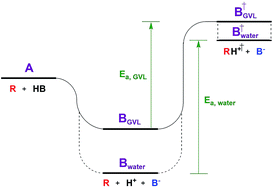
Chem. Sci., 2018,9, 281-287
https://doi.org/10.1039/C7SC03728G
Reactivity control of a photocatalytic system by changing the light intensity
By using simple optics such as a lens, switching between one- and two-photon driven reaction mechanisms became feasible, which allows the control over the main products of photochemical reactions.
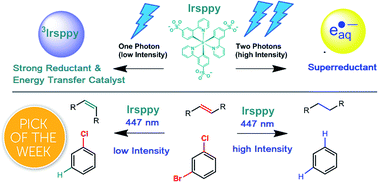
Chem. Sci., 2019,10, 11023-11029
https://doi.org/10.1039/C9SC04584H
A visible-light mediated three-component radical process using dithiocarbamate anion catalysis
A three-component radical process is reported that, by coupling alkyl chlorides, maleimides, and heteroaromatic fragments, installs multiple biologically relevant heterocycles within complex cascade products. This method, which generates radicals via an SN2-based photochemical catalytic mechanism, activates substrates incompatible with or inert to classical radical-generating strategies.
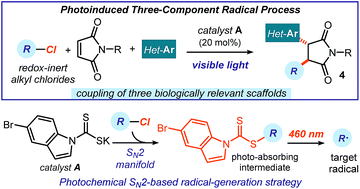
Chem. Sci., 2019,10, 5484-5488
https://doi.org/10.1039/C9SC00833K
Photoinitiated carbonyl-metathesis: deoxygenative reductive olefination of aromatic aldehydes via photoredox catalysis
Carbonyl–carbonyl olefination, known as McMurry reaction, represents a powerful strategy for the construction of olefins.
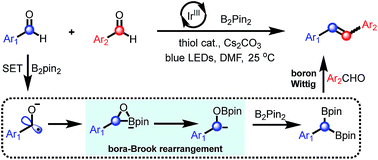
Chem. Sci., 2019,10, 4580-4587
https://doi.org/10.1039/C9SC00711C
Nickel-catalyzed C–N bond activation: activated primary amines as alkylating reagents in reductive cross-coupling
The reductive cross coupling of pyridinium salts derived from readily available primary alkyl amines with aryl halides has been achieved under mild reaction conditions using a nickel catalyst.
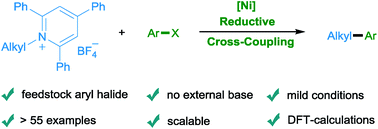
Chem. Sci., 2019,10, 4430-4435
https://doi.org/10.1039/C9SC00783K
Catalytic asymmetric allylation of aldehydes with alkenes through allylic C(sp3)–H functionalization mediated by organophotoredox and chiral chromium hybrid catalysis
We have developed a catalytic asymmetric nucleophilic allylation of aldehydes using simple alkenes as pronucleophiles without relying on stoichiometric metals.
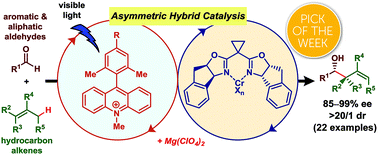
Chem. Sci., 2019,10, 3459-3465
https://doi.org/10.1039/C8SC05677C
Nickel-catalyzed anti-Markovnikov hydroarylation of alkenes
We have developed a nickel-catalyzed anti-Markovnikov hydroarylation of alkenes using aryl halides as coupling partners.

Chem. Sci., 2019,10, 3231-3236
https://doi.org/10.1039/C8SC05445B
Low overpotential water oxidation at neutral pH catalyzed by a copper(II) porphyrin
Low-overpotential water oxidation catalyzed by copper(II) porphyrin to produce O2 in neutral aqueous solution and H2O2 in acidic solution.
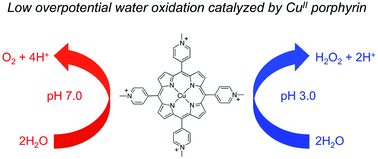
Chem. Sci., 2019,10, 2613-2622
https://doi.org/10.1039/C8SC04529A
Ni-catalysed reductive arylalkylation of unactivated alkenes
Ni-catalyzed reductive two-component arylalkylation of unactivated olefins has been accomplished providing a path for a variety of benzene-fused carbo- and heterocyclic compounds.

Chem. Sci., 2019,10, 1780-1785
https://doi.org/10.1039/C8SC04279A
Nickel-catalyzed allylic defluorinative alkylation of trifluoromethyl alkenes with reductive decarboxylation of redox-active esters
Synthesis of functionalized gem-difluoroalkenes was achieved through nickel-catalyzed allylic defluorinative alkylation of trifluoromethyl alkenes with reductive decarboxylation of redox-active esters.

Chem. Sci., 2019,10, 809-814
https://doi.org/10.1039/C8SC04335C
Ir(III)-catalyzed ortho C–H alkylations of (hetero)aromatic aldehydes using alkyl boron reagents
The direct Ir(III)-catalyzed ortho C–H alkylations of (hetero)aromatic aldehydes have been accomplished using aniline as the transient ligand and alkyl boron reagents as the coupling partner.

Chem. Sci., 2018,9, 8951-8956
https://doi.org/10.1039/C8SC03606C
Carbon-supported Ni nanoparticles for efficient CO2 electroreduction
Carbon-coated Ni nanoparticles supported on N-doped carbon enable efficient electroreduction of CO2 to CO comparable to single Ni sites.
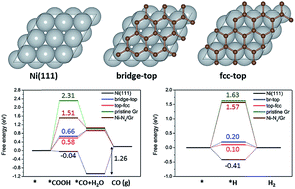
Chem. Sci., 2018,9, 8775-8780
https://doi.org/10.1039/C8SC03732A
meta-C–H arylation of fluoroarenes via traceless directing group relay strategy
The first example of direct meta-C–H arylation of fluoroarenes to provide valuable meta-fluorobiaryls is achieved by exploiting CO2 as a transient directing group that enables complete regiochemical control of the arylation event.
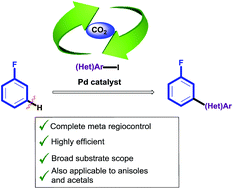
Chem. Sci., 2018,9, 7133-7137
https://doi.org/10.1039/C8SC02417K
Fine-tuned organic photoredox catalysts for fragmentation-alkynylation cascades of cyclic oxime ethers
Fine-tuned organic photoredox catalysts are introduced for the metal-free alkynylation of alkylnitrile radicals generated via oxidative ring opening of cyclic alkylketone oxime ethers.

Chem. Sci., 2018,9, 5883-5889
https://doi.org/10.1039/C8SC01818A
The chemical identity, state and structure of catalytically active centers during the electrochemical CO2 reduction on porous Fe–nitrogen–carbon (Fe–N–C) materials
We report novel structure–activity relationships and explore the chemical state and structure of catalytically active sites under operando conditions during the electrochemical CO2 reduction reaction (CO2RR) catalyzed by a series of porous iron–nitrogen–carbon (FeNC) catalysts.
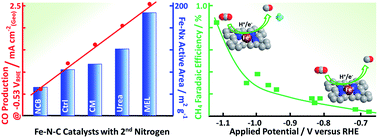
Chem. Sci., 2018,9, 5064-5073
https://doi.org/10.1039/C8SC00491A
Gold-catalyzed (4 + 2)-annulations between α-alkyl alkenylgold carbenes and benzisoxazoles with reactive alkyl groups
This work reports new (4 + 2)-annulations of α-alkyl vinylgold carbenes with benzisoxazoles to afford 3,4-dihydroquinoline derivatives with high anti-stereoselectivity.

Chem. Sci., 2018,9, 4488-4492
https://doi.org/10.1039/C8SC00986D
Trends in activity for the oxygen evolution reaction on transition metal (M = Fe, Co, Ni) phosphide pre-catalysts
A notable trend in OER activity on transition metal phosphide pre-catalysts is reported. Remarkably, the tri-metallic FeCoNiP pre-catalysts exhibit exceptional apparent and intrinsic OER activities, outperforming many non-precious OER catalysts reported previously.
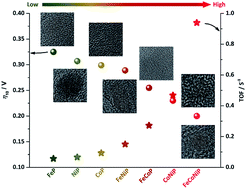
Chem. Sci., 2018,9, 3470-3476
https://doi.org/10.1039/C7SC05033J
Engaging sulfinate salts via Ni/photoredox dual catalysis enables facile Csp2–SO2R coupling
A new, mild, functional-group tolerant approach to the construction aryl- and heteroaryl sulfones via Ni/photoredox dual catalysis is described.

Chem. Sci., 2018,9, 3186-3191
https://doi.org/10.1039/C7SC05402E
Positional effects of second-sphere amide pendants on electrochemical CO2 reduction catalyzed by iron porphyrins
The development of catalysts for electrochemical reduction of carbon dioxide offers an attractive approach to transforming this greenhouse gas into value-added carbon products with sustainable energy input.
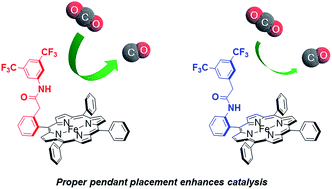
Chem. Sci., 2018,9, 2952-2960
https://doi.org/10.1039/C7SC04682K
Gold-catalyzed [4+3]- and [4+2]-annulations of 3-en-1-ynamides with isoxazoles via novel 6π-electrocyclizations of 3-azahepta trienyl cations
Gold-catalysed [4+3]- and [4+2]-annulations of 3-substituted 3-en-1-ynamides with isoxazoles were achieved with Au(I) and Au(I)/Zn(II) catalysts respectively.
![Graphical abstract: Gold-catalyzed [4+3]- and [4+2]-annulations of 3-en-1-ynamides with isoxazoles via novel 6π-electrocyclizations of 3-azahepta trienyl cations](/en/Image/Get?imageInfo.ImageType=GA&imageInfo.ImageIdentifier.ManuscriptID=C8SC00232K&imageInfo.ImageIdentifier.Year=2018)
Chem. Sci., 2018,9, 2991-2995
https://doi.org/10.1039/C8SC00232K
Tailored trisubstituted chiral CpxRhIII catalysts for kinetic resolutions of phosphinic amides
A trisubstituted chiral Cpx ligand family is introduced.
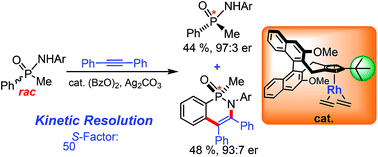
Chem. Sci., 2018,9, 2981-2985
https://doi.org/10.1039/C7SC05411D
Electronic modulation of transition metal phosphide via doping as efficient and pH-universal electrocatalysts for hydrogen evolution reaction
The electronic modulation of the host catalyst via doping provides a new strategy to efficiently boost the HER activity of transition metal phosphides.
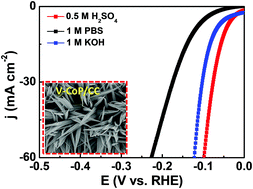
Chem. Sci., 2018,9, 1970-1975
https://doi.org/10.1039/C7SC04849A
Ni-catalysed regioselective 1,2-diarylation of unactivated olefins by stabilizing Heck intermediates as pyridylsilyl-coordinated transient metallacycles
Ni-catalysed diarylation of vinylpyridylsilanes with arylzinc reagents and aryl halides is reported by stabilizing Heck intermediates as pyridylsilyl-coordinated transient metallacycles.

Chem. Sci., 2018,9, 904-909
https://doi.org/10.1039/C7SC04351A
Cobalt-catalyzed regioselective stereoconvergent Markovnikov 1,2-hydrosilylation of conjugated dienes
The first transition metal-catalyzed stereoconvergent Markovnikov 1,2-hydrosilylation of (E/Z)-dienes was effectively achieved with excellent E-selectivities using a cobalt catalyst.
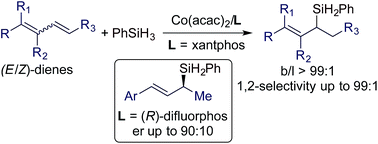
Chem. Sci., 2018,9, 973-978
https://doi.org/10.1039/C7SC04002D
Scalable thioarylation of unprotected peptides and biomolecules under Ni/photoredox catalysis
A mechanistically distinct, Ni/photoredox-catalyzed arylation of unprotected, native thiols (e.g., cysteine residues) is reported – a process initiated through a visible light-promoted, hydrogen atom transfer (HAT) event under ambient conditions.
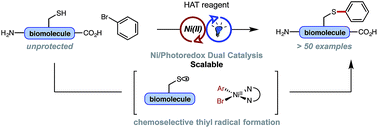
Chem. Sci., 2018,9, 336-344
https://doi.org/10.1039/C7SC04292B
Doping palladium with tellurium for the highly selective electrocatalytic reduction of aqueous CO2 to CO
The doping of Pd with a small amount of Te can selectively convert CO2 to CO with a low overpotential.
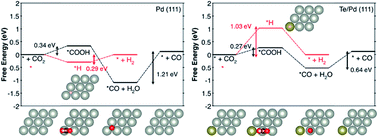
Chem. Sci., 2018,9, 483-487
https://doi.org/10.1039/C7SC03018E
About this collection
This specially curated collection pulls together some of the most popular articles from 2018 and 2019 in the field of catalysis. The collection presents some outstanding contributions to the field, ranging from Pd doped with Te for the highly selective electrocatalytic reduction of aqueous CO2 to a review of catalyst characterization in the presence of solvent through liquid phase structure-activity relationships, and as with all Chemical Sciene articles - they are all completely free to access and read. We hope you enjoy browsing through this collection.
See also: